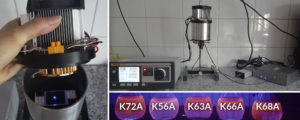M Topa, J Ortyl, A Chachaj-Brekiesz, I Kamińska-Borek… – Spectrochimica Acta Part A …, 2018
Faculty of Chemical Engineering and Technology, Cracow University of Technology, Warszawska
Faculty of Chemistry, Jagiellonian University, Ingardena 3, 30-060 Cracow, Poland
Highlights
- • The samarium complexes can be used as the thickness sensors for acrylic coatings.
- • The relative intensity of the samarium emission can be used as the parameter to monitoring of the cationic polymerization.
- • The samarium complexes can be used as candidates for marking high-value polymeric products to protect them from counterfeits.
Abstract
Applicability of 15 trivalent samarium complexes as novel luminescent probes for monitoring progress of photopolymerization processes or thickness of polymer coatings by the Fluorescence Probe Technique (FPT) was studied. Three groups of samarium(III) complexes were evaluated in cationic photopolymerization of triethylene glycol divinyl ether monomer (TEGDVE) and free-radical photopolymerization of trimethylolpropane triacrylate (TMPTA). The complexes were the derivatives of tris(4,4,4-trifluoro-1-(2-thienyl)-1,3-butanedionate)samarium(III), tris(4,4,4-trifluoro-1-phenyl-1,3-butanedionate)samarium(III) and tris(4,4,4-trifluoro-1-(2-naphthyl)-1,3-butanedionate)samarium(III), which were further coordinated with auxiliary ligands, such as 1,10-phenanthroline, triphenylphosphine oxide, tributylphosphine oxide and trioctylphosphine oxide. It has been found that most of the complexes studied are sensitive enough to be used as luminescent probes for monitoring progress of cationic photopolymerization of vinyl ether monomers over entire range of monomer conversions. In the case of free-radical polymerization processes, the samarium(III) complexes are not sensitive enough to changes of microviscosity and/or micropolarity of the medium, so they cannot be used to monitor progress of the polymerization. However, high stability of luminescence intensity of some of these complexes under free-radical polymerization conditions makes them good candidates for application as thickness sensors for polymer coatings prepared by free-radical photopolymerization. A quantitative relationship between a coating thickness and the luminescence intensity of the samarium(III) probes has been derived and verified experimentally within a broad range of the thicknesses.

… prepared. The absorption spectra were recorded at 25 °C, using Silver-Nova spectrometer (StellarNet, Inc., USA) in combination with a broadband tungsten- deuterium UV–Vis light source and a quartz cuvette with 1.0 cm optical path …





